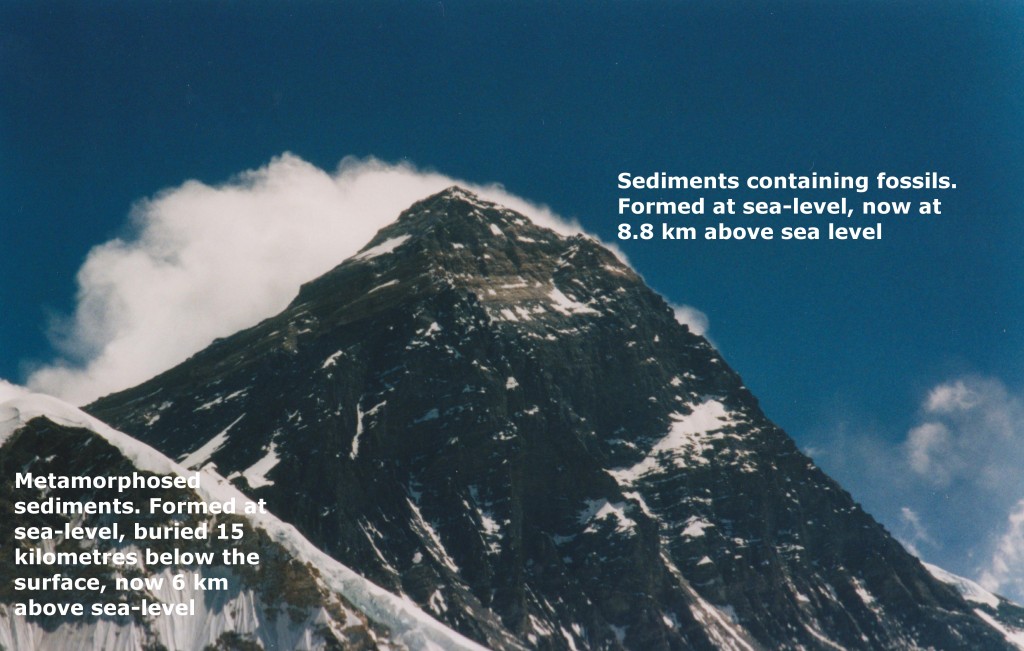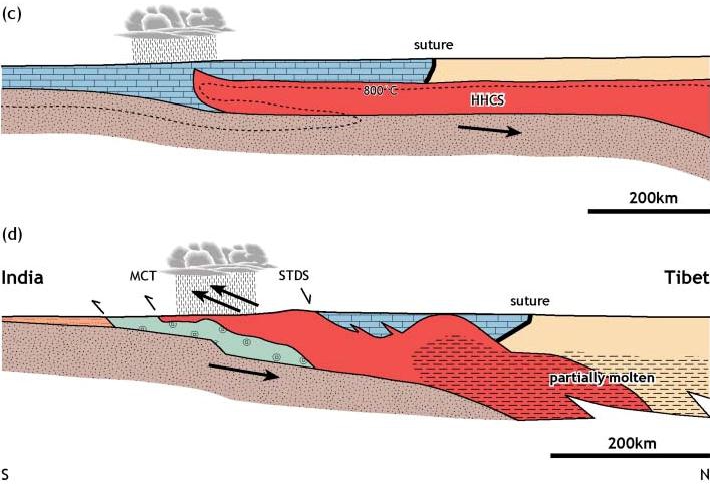Leonardo da Vinci, famed artist and Renaissance “Renaissance Man” made some interesting remarks about Geology. When he looked at rocks in the Alps containing fossil molluscs, it was clear to his trained eye that the fossils were near identical to shells formed by creatures in the sea. That fossils are the remains of ancient creatures seems obvious now, but was a controversial idea at the time. This makes it even more impressive that he made the further step of thinking about how things that formed in the sea ended up on the top of mountains.
We now know that the highest peaks in the world – such as Mount Everest – are formed from ancient marine sediments. When we think about a coral – that grew safe and snug in a warm ocean that no longer exists – now lifted up 9 km to form the top of Mount Everest, the only proper response is awe. The rocks just below are even more amazing. They started in the sea but they’ve been buried 15 kilometres below the surface, partly melted and then drawn up to the surface by snow and rain.
Channel flow
If you bury the right sort of rocks in the right sort of way, they form a hot soft layer in the middle of the crust. In Asia, a soft layer is formed by the collision between the Indian and Asian plates stuff sediments (rich in heat-forming radioactive elements) down under the Tibetan Plateau. Stuck between a cold rigid layer (the upper crust) and a strong rigid layer (lithospheric mantle) this soft layer is like jelly (jam) in a sandwich. In special places on either end of the Himalayas, this ‘jam’ squeezes to the surface via a process of extrusion in a ‘tectonic aneurysm’. Extrusion is a particular case where the middle crust ‘jam’ reaches the surface, the more general concept is called channel flow.
The idea of channel flow was born on the INDEPTH geophysical surveys of the Tibetan plateau, led by Doug Nelson. These suggested that there is molten rock beneath Tibet right now. At the same time, geologists across the the Himalayas were puzzling over a thick layer of metamorphic and igneous rocks (High Himalayan Crystalline Series, below) that looked as if it had been squeezed out from underneath Tibet. Channel flow puts these the two observations together – hot rocks generated beneath Tibet flowed, lubricated by molten granite, out into the high Himalaya.
In 2004, there was a conference hosted by the Geological Society of London on the subject. This brought a fantastic range of techniques to bear on the problem – geophysics, mathematical modelling and a wide range of geological studies. The ‘special publication’ based on this conference is a fantastic resource; it mixes maths-rich papers – modelling the patterns of flow that are possible, with papers full of pictures of rocks – inferring how they flowed in the past.
It’s a big thick book, but in a sentence it goes as follows. “Hot rocks in the middle crust of Tibet have formed a weak ‘channel’ that flows laterally out from areas of over-thickened crust (probably, but more research etc…)”. There are two main ways this lateral flow of ‘the jam’ can happen.
Something moving deep inside
Imagine you are standing in eastern China looking west at the Tibetan mountains – what does the future hold? Channel flow predicts that hot middle crustal rocks are flowing into the crust below your feet. Deep below, a continuous slow shuffling of atoms in lattices is changing the shape of mineral grains. With enough time, small things make big changes and solid rock can creep and flow and squeeze itself along. The ground you are standing on is ever so slowing being jacked up. In time it will be several kilometres higher and part of a wider Tibetan Plateau. The pandas will be gone, replaced by yaks.
This process would take millions of years longer than a human lifespan, or course and there is little solid evidence it will happen in the future. It almost certainly happened in the past though – there is evidence from river gorges in eastern Tibetan of 1.5km uplift in the last 5 million years. Channel flow is a convincing mechanism to explain how this happened.
Hot rocks, big glaciers and the world’s tallest mountain
It is quite hard to know what is going on 20km below your feet. Places where the channel reaches the surface are easier to understand as you can do Geology at the surface, studying the cooled channel rocks (the ‘fossil jam’). A 2007 JGS review paper by Nigel Harris of Britain’s Open University (available free online) looks in particular at the rocks found on the southern edge of the Tibetan plateau – the Himalayas.
One of the key observations leading to the proposal of channel flow was the observation that metamorphic rocks of the High Himalayan Crystalline Series – “HHCS” are bounded between two fault systems. Underneath there are thrust faults, above there are extensional faults, notably the South Tibetan Detachment System – “STDS” (not STDs, oh no). The combined sense of movement of these faults is to push the metamorphic rocks out. These metamorphic rocks acted in the past as a hot flowing channel, moving from under Tibet out and along to form the world’s tallest mountains.
This cross-section shows the channel flow model. Underneath the Tibetan Plateau, a hot (red) channel of soft rocks forms in the middle crust (the scale is very large so the topography is not very apparent). The stippled grey/brown material is the Indian Crust moving underneath. The Tibetan Plateau heats up in Spring and pulls moist air off the Indian Ocean up north over the Indian sub-continent to form the monsoon. Little of it gets beyond the southern edge of the plateau (cloud in the diagram) as the mountains cause precipitation. The enhanced erosion, from rain, rivers and glaciers causes exhumation (like at Nanga Parbat) and starts to draw the channel to the surface. The lower diagram shows a slightly later stage, showing specific tectonic features. Enhanced erosion on the Himalaya front initiates a flow of material that reaches deep into the crust and 100s km laterally under the Tibetan Plateau.
This is such a beautiful idea that it ought to be true. But is it?
After extensively reviewing other models and all available evidence, Harris makes some interesting conclusions. First, “There can be little doubt that the high-grade rocks of the Himalaya were extruded southward, bounded by thrusting below and normal faults and shear zones below” so the metamorphic rocks were squeezed out as a package. Further, “evidence is emerging that is largely consistent with the hypothesis that southward extrusion during the Early to Mid-Miocene was facilitated by channel flow”, so it has happened, if only for a while 20-15 million years ago.
There is much less evidence that channel flow in the Himalayas has been happening since. Current day zones of high exhumation and high rainfall are found further south where they are associated with brittle thrusting in lower grade rocks. This can be explained by viscous wedge models rather than by channel flow.
Rain and snow is amazing stuff. For a period of time it was able to influence rocks deep under the surface and 100s kms away, enticing metamorphic rocks to flow towards the surface where they can be broken into pieces and washed away back to the sea. The precipitation patterns are controlled by topography which is controlled by tectonics which is influenced by precipitation patterns… We make stories about the world, as that is the way our minds work, but a world where everything is so deeply connected can’t be reduced to our simple linear narratives.
In his paper, Nigel Harris discusses further links between precipitation and tectonics; he considers the ways in which higher rates of precipitation in the eastern Himalaya affect tectonic features. Granites associated with channel flow are younger in (rainier) Bhutan than further west. The evidence is equivocal, but the idea that climate and tectonics have been linked for the past 20 million years and over thousands of kilometres may yet be proved right. That’s (even) more interesting than a few high-altitude fossils. If only Leonardo da Vinci were here to know it.
References and image sources
The Harris paper is available free via the Open University’s open research archive.
Harris, N. (2007). Channel flow and the Himalayan-Tibetan orogen: a critical review Journal of the Geological Society, 164 (3), 511-523 DOI: 10.1144/0016-76492006-133
Godin, L., Grujic, D., Law, R., & Searle, M. (2006). Channel flow, ductile extrusion and exhumation in continental collision zones: an introduction Geological Society, London, Special Publications, 268 (1), 1-23 DOI: 10.1144/GSL.SP.2006.268.01.01
Everest picture my own, diagrams from Harris (2007) with permission of author, rainy Himalayan picture from nandadevieast on Flickr under Creative Commons.





Pingback: The Geology of Mount Everest | Metageologist
Pingback: How old is plate tectonics? | Metageologist
Pingback: toshiba.tweakcoders.in» Blog Archive » Interactive Geologic Map And Cross Section Of Kumaon Lesser Himalayas In Shama Gogina Region
Pingback: trix.tweakcoders.in» Blog Archive » Interactive Geologic Map And Cross Section Of Kumaon Lesser Himalayas In Shama Gogina Region
This is nicely written. These ancient civilizations are amazing. Here is one on the Olmecs http://www.omec-arkofthecovenantmystery.com/olmec/stone-grinders-of-ancient-origin/.
Ok. If true, Either possibilities must exist. 1. A corresponding deepening of the Tibetan plate, sea floor or similar geo structure, or 2. Air, water or other empty space supports the mass that now fills the mountain ranges (ha ha ha!) or 3. The earth must have shrunk. O.W., geology sounds like another silly Noah’s Ark tale. Remember, geologists got to somehow show where all the mass of continents, not just gigantic mountain ranges, came from. Meteor showers? OR has earth become seriously honeycombed? Has earth shrivled like an orange? And what is, at point zero, fueling the flow that moves these giganteous titannic plates to move? It would’nt be the sun. Could it be Gravity? Convection? Osmosis? Nuclear turbulence from earth’s core? Dumbfouned? Show me a pair of sissors and I’ll show you undisputable evidence mankind exists. Examine a tree and you’ll have complete evidence that God has hands like a man.
Very nice site!
whoah this blog is fantastic i really like studying your articles. Keep up the good paintings! You understand, many individuals are looking around for this info, you could aid them greatly. kddgbdkecfbdabcc
Pingback: The Himalayan mountains: flow and fracture | Metageologist